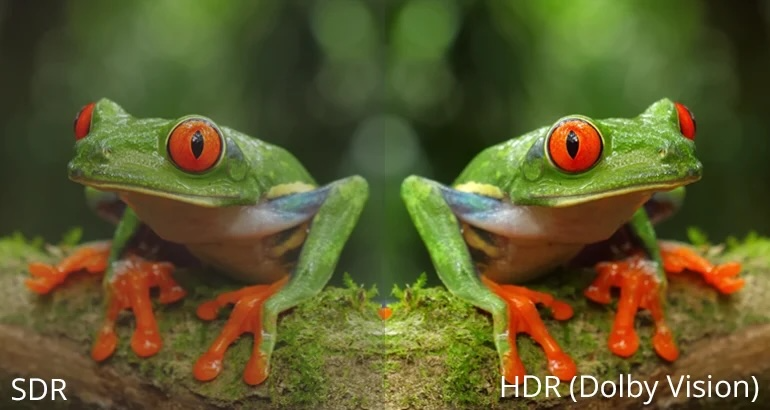Software developers at Unified Streaming have been busy working to refine the company’s code base. With the latest GA (version 1.15.13), you can stream more efficiently, and more expertly.
Here are some highlighted features and fixes that may interest you.
🎺 DASH: always add supplemental codecs and profiles for Dolby Vision representations (#9466).
This addition improves compliance with Dolby Vision codecs and profiles.

Dolby Vision is a format that gives you a premium feel while watching content. With Dolby Vision's high dynamic range (HDR) imaging technology, you get fuller color range, superior contrast, improved brightness, and dynamic metadata.
We’ve supported the Dolby Vision format for DASH output since April 2016 (#humblebrag).
Query eye for the parameter guy
🎺 HLS: added 'hls_can_skip_dateranges=false' query parameter to fallback to version 1 delta updates (_HLS_skip=YES, instead of _HLS_skip=v2).
We support so-called HLS Playlist Delta Updates, which is supposed to decrease latency for HTTP Live Streaming (see HLS Playlist Delta Updates for more information). The idea is that a player can request “deltas” of playlists, meaning just the difference between old and new playlists, instead of having to request the whole new playlist.
There are currently two versions of HLS Playlist Delta Updates: version 1 and version 2. Version 2 includes all the functionality of version 1, but it can also skip over so-called EXT-X-DATERANGE tags.
The hls_can_skip_dateranges=false query parameter makes Unified Origin fall back to version 1, which is designed to support player software that cannot yet handle version 2.
HLS is everywhere. It’s a widely adopted standard for delivering video over the internet. If you have a device that streams video, very likely it can stream HLS.
And if you appreciate low latency, or minimal delay between requesting the video and playing it (and we know that you really do, unless you’re not human), then it’s highly likely you’d appreciate that HLS Playlist Delta Updates can decrease that lag time, or latency.

HLG doesn’t mean Hungry Little Guy
🎺 CMAF: add two 'colr' boxes for HLG. The first having transfer_characteristics of HLG, and the second one SDR (#9465).
🎺 DASH: when using the urn:dvb:dash:profile:dvb-dash:2014 profile identifier and signaling HLG10, we omit the three EssentialProperty VUI descriptors. A single SupplementalProperty descriptor for the alternative transfer characteristics is used instead. Reference: ETSI TS 103 285 V1.3.1 (2020-02).
🎺 HLS: signal VIDEO-RANGE=HLG also for backwards-compatible HLG10 video.
🎺 libfmp4: added clg1 compatibility brand to signal HLG10 media profile.
These four updates, in general, help reach our aim of supporting a fully compliant HLG, together with the BBC.
HLG is a royalty-free format designed for live broadcasts and compatibility with both SDR (Standard Dynamic Range) and HDR (High Dynamic Range) display. The HLG format was jointly developed by the BBC and NHK, primarily for live television and surveillance applications.
HLG offers backward compatibility with SDR (Standard Dynamic Range) displays, making the format ideal for live broadcasts and a wide range of viewers. HLG also allows for efficient delivery of HDR (High Dynamic Range) content without requiring metadata or complex tone mapping, which can introduce latency or artifacts.
What’s tone mapping? It’s a technique that HDR uses to modulate the brightness and color range of an image or video. You know this. It’s so that devices with a smaller dynamic range (like SDR displays) can show images and video in the best possible way. Heard of upcycling? Tone mapping’s like taking your worn-out jeans and giving them a glow-up.
FFmpeg gets cleaner bill of health
🎺 Updated FFmpeg to 8.0.
FFmpeg is a popular, open-source multimedia framework, and people and companies use the framework to record, convert, and stream audio and video. FFmpeg’s newest software release, 8.0, is nicknamed “Huffman.”
Don’t be fooled. The codename has nothing to do with American actress Felicity Huffman, who did jail time in 2019 for paying someone to doctor her daughter’s SAT test score, to improve her chances of getting into a good university.

The actress is back in business as Dr Joan Ridley on FOX’s new show Doc. Love her or leave her, Huffman’s here to stay.
If you’re in the streaming business, you’re using, will use, or have used, FFmpeg. The cross-platform solution supports lotsa codecs such as H.264, H.265, VP9, and AAC, and file formats. So gaining support for the latest version of FFmpeg via Unified Streaming’s new release, well, it helps.

Alpine Linux 3.22: rarified air
🎺 Added support for Alpine Linux 3.22.
What’s it mean? Well, Linux is a kernel, or core component of an operating system, as well as a collection of operating systems. Alpine Linux is a very secure and lightweight distribution, or user-friendly package, of Linux. Upgrading support for Alpine Linux 3.22 means staying current with the most recent version of Alpine Linux.
Using Alpine Linux for streaming applications is popular. So if your operating système du jour is Alpine Linux, Unified has made it easier for you to stay current and run Unified Streaming’s platform of products without missing a step.

Debian-utante
🎺 Added support for Debian 13.
Debian’s a free, open-source operating system, developed by volunteers. Known for its stability and security, Debian serves as the foundation for many other popular Linux distributions such as Ubuntu. Debian 13, code named “trixie,” was two years plus in the making, and will be supported for five years.
From debian.org:
“With this broad selection of packages and its traditional wide architecture support, Debian once again stays true to its goal of being The Universal Operating System. It is suitable for many different use cases: from desktop systems to netbooks; from development servers to cluster systems; and for database, web, and storage servers. At the same time, additional quality assurance efforts like automatic installation and upgrade tests for all packages in Debian's archive ensure that trixie fulfills the high expectations that users have of a stable Debian release.
“This release for the first time officially supports the riscv64 architecture, allowing users to run Debian on 64-bit RISC-V hardware and benefit from all Debian 13 features.”
Again, don’t let Debian 13’s code name trick you. “Trixie” shouldn’t be confused with Trixie Belden, the title character in a series of American mystery books written between 1948 and 1986. Trixie Belden was a teen detective, back when teens could be detectives. A few book covers:

Do you use Debian? Then gaining support for its latest software version is an advantage. Just don’t forget that “trixie” has nothing to do with Trixie Belden, please, and thank you.
Farewell, Ubuntu 20.04
🎺 Removed support for Ubuntu 20.04.
Ubuntu’s a free, open-source, Linux-based operating system, designed as a user-friendly and accessible platform for various devices, from desktops and servers, to IoT devices and robots.
20.04 is no longer supported. Its code name is “Focal Fossa.” Here is a fossa. Good night, fossa.

Ubuntu is an ancient African word meaning “humanity to others.” In other words, “I am who I am because of who we all are.” Be good to others and even to fossas, who face not extinction, but deprecation.
Just because Focal Fossa is canceled doesn’t mean you can’t adopt another species. Consider these: Plucky Puffin, Oracular Oriole, Noble Numbat, and Jammy Jellyfish. They’re all still supported. Here’s a numbat.

By the way, a pet-to-human AI generator says if a numbat (on the left, below) were a man, he’d look like this, the picture on the right:

Live and VOD: how time (mis)behaves
🎺 Origin: set the Last-Modified header to the end time of last segment, once a live playlist switches to VOD (#9426).
There are two types of playlists: static (aka VOD) and dynamic (aka live).
When you are watching a live presentation, and the program somehow ends, at some point it will transition from live to VOD, that is, dynamic to static.
Whenever a playlist is dynamic, we set the HTTP Last-Modified header to the time of the last ingested segment. Usually this is the so-called “Live Edge.”
Now when it transitions to static, we used to set the Last-Modified header to the time of the server manifest (the .isml file). This confused customers, because that made the Last-Modified time go backwards!
Here’s the fix: we now set the Last-Modified header for such a playlist to the time of the last segment, which makes much more sense.
But why the fix?
As carbon-based forms, with definite start times and unpredictable end times, we all understand and process time as a chronological phenomenon. We probably wouldn’t like it if time went backwards. Déjà-vu is about all we can handle.
We say: in life, just as in dynamic playlist management, let time shuffle forward, not scrub in reverse.
Since we set the Last-Modified time to the time of the last segment, instead of the time of the server manifest, we can all manage time as a forward-moving thing.

End
You’ve reached the end of this blog about the new GA release. Please don’t fret. All blogs end.
For more info, and for the full list of changes in the GA, check out the release notes here.
And if you have questions, please email us at sales@unified-streaming.com.
